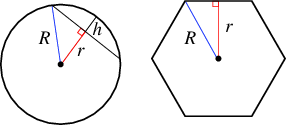The line
segment from the
center of a regular polygon to
the midpoint of a side, or
the length of this segment. Same as the inradius;
that is, the
radius of
a regular polygon's inscribed
circle.
Note: Apothem is pronounced with the emphasis on the first syllable with the a pronounced as in apple (A-puh-thum).
Apothem
 Given a circle, the apothem is the perpendicular distance
Given a circle, the apothem is the perpendicular distance The apothem is also the radius of the incircle of the polygon. For a polygon of n sides, there are n possible apothems, all the same length of course. The word apothem can refer to the line itself, or the length of that line. So you can correctly say 'draw the apothem' and 'the apothem is 4cm'.
Each formula below shows how to find the length of the apothem of a regular polygon. Use the formula that uses the facts you are given to start.
Apothem given the length of a side.
By definition, all sides of a regular polygon are equal in length. If you know the length of one of the sides, the apothem length is given by the formula: wheres is the length of any side
n is the number of sides
tan is the tangent function calculated in degrees (see Trigonometry Overview)
Apothem given the radius (circumradius)
If you know the radius (distance from the center to a vertex): wherer is the radius (circumradius) of the polygon
n is the number of sides
cos is the cosine function calculated in degrees (see Trigonometry Overview)
Irregular Polygons
Since irregular polygons have no center, they have no apothem. In the figure above, uncheck the "regular" checkbox and note how there can be no center or apothem.Example :
How can I find the apothem of a regular pentagon given the only the side lengths?
The only 2 information given is that the pentagon is a regular polygon and that the side lengths are 5. Can someone not only give me the answer, but also explain it?
Answer : 1) Draw a straight horizontal line. It doesn't have to be too long. This line will represent one of the sides of your polygon. In your case, it's one of the 5 sides of the regular polygon.
2) Now from the middle of that line, draw a line straight up, so that the two lines are perpendicular. This second line drawn is the "apothem." This is the segment's length your trying to find. Let's call it "b".
3) Finally draw one more line...connecting the top of the apothem (which is the center of your polygon) to either end of the first line you drew (it doesn't matter which end - left or right). We don't know this length either. Let's call it "c".
Now that you have a triangle picture, let's call 1/2 of the first line you drew "a", and its length = 2.5, since it is half the length of each side of the polygon.
Using the fact that this pentagon is "regular" (convex and equilateral), you can find the angle that is formed between sides "a" and "c". To do this, first determine what each interior angle in this regular pentagon equals. You've probably already learned that a 5-sided convex polygon's interior angles add up to 3 x 180 degrees = 540 degrees. So, since the pentagon is regular: 540 / 5 = 108 degrees. That's how large each interior angles is. But, the angle we're interested in (the one between "c" and "a") is exactly half of 108 degrees or 54 degrees.
Ok, so here's your picture:
|\
| \ ` c
|__\
` a
In this picture "b" is the vertical line on the left.
Remember, side "b" is the "apothem". You know the length of "a" and the angle between "a" and "c".
Finally, using trigonometry, specifically tangent, you can find the length of "b".
tan 54 = b / 2.5
I'm getting b = 3.44 (rounded to two decimal places)
No comments:
Post a Comment